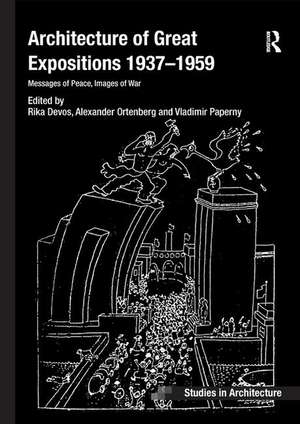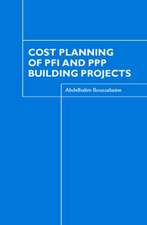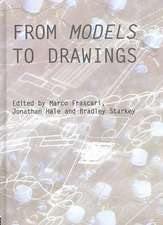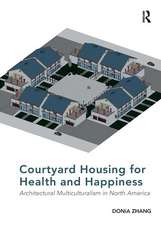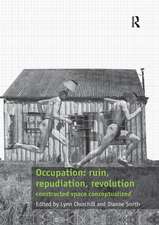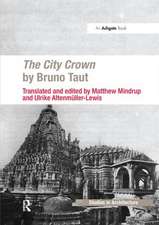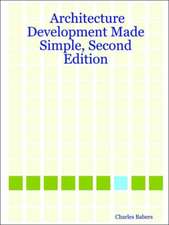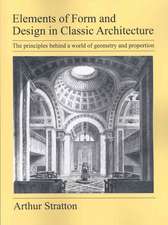Architecture of Great Expositions 1937-1959: Messages of Peace, Images of War: Ashgate Studies in Architecture
Autor Rika Devos, Alexander Ortenbergen Limba Engleză Paperback – 12 oct 2017
Din seria Ashgate Studies in Architecture
- 8%
 Preț: 383.36 lei
Preț: 383.36 lei - 26%
 Preț: 820.71 lei
Preț: 820.71 lei - 22%
 Preț: 329.91 lei
Preț: 329.91 lei - 25%
 Preț: 768.30 lei
Preț: 768.30 lei - 11%
 Preț: 362.88 lei
Preț: 362.88 lei - 12%
 Preț: 325.34 lei
Preț: 325.34 lei - 22%
 Preț: 324.16 lei
Preț: 324.16 lei - 25%
 Preț: 826.84 lei
Preț: 826.84 lei - 25%
 Preț: 776.81 lei
Preț: 776.81 lei -
 Preț: 441.89 lei
Preț: 441.89 lei - 25%
 Preț: 770.31 lei
Preț: 770.31 lei - 25%
 Preț: 823.99 lei
Preț: 823.99 lei - 22%
 Preț: 324.16 lei
Preț: 324.16 lei - 25%
 Preț: 881.28 lei
Preț: 881.28 lei - 13%
 Preț: 338.33 lei
Preț: 338.33 lei -
 Preț: 461.48 lei
Preț: 461.48 lei - 25%
 Preț: 886.47 lei
Preț: 886.47 lei - 12%
 Preț: 328.00 lei
Preț: 328.00 lei - 25%
 Preț: 767.07 lei
Preț: 767.07 lei - 18%
 Preț: 995.79 lei
Preț: 995.79 lei -
 Preț: 461.48 lei
Preț: 461.48 lei - 25%
 Preț: 826.43 lei
Preț: 826.43 lei - 26%
 Preț: 850.54 lei
Preț: 850.54 lei - 25%
 Preț: 710.66 lei
Preț: 710.66 lei - 13%
 Preț: 338.33 lei
Preț: 338.33 lei - 25%
 Preț: 767.67 lei
Preț: 767.67 lei - 13%
 Preț: 338.33 lei
Preț: 338.33 lei - 13%
 Preț: 338.33 lei
Preț: 338.33 lei - 26%
 Preț: 821.82 lei
Preț: 821.82 lei - 26%
 Preț: 821.53 lei
Preț: 821.53 lei - 25%
 Preț: 827.64 lei
Preț: 827.64 lei - 25%
 Preț: 767.93 lei
Preț: 767.93 lei - 26%
 Preț: 821.53 lei
Preț: 821.53 lei - 25%
 Preț: 799.76 lei
Preț: 799.76 lei - 25%
 Preț: 823.08 lei
Preț: 823.08 lei - 25%
 Preț: 826.01 lei
Preț: 826.01 lei - 25%
 Preț: 769.51 lei
Preț: 769.51 lei
Preț: 333.86 lei
Preț vechi: 375.99 lei
-11% Nou
Puncte Express: 501
Preț estimativ în valută:
63.92€ • 66.56$ • 53.04£
63.92€ • 66.56$ • 53.04£
Carte tipărită la comandă
Livrare economică 14-28 februarie
Preluare comenzi: 021 569.72.76
Specificații
ISBN-13: 9781138573352
ISBN-10: 1138573353
Pagini: 256
Dimensiuni: 174 x 246 x 21 mm
Greutate: 0.86 kg
Ediția:1
Editura: Taylor & Francis
Colecția Routledge
Seria Ashgate Studies in Architecture
Locul publicării:Oxford, United Kingdom
ISBN-10: 1138573353
Pagini: 256
Dimensiuni: 174 x 246 x 21 mm
Greutate: 0.86 kg
Ediția:1
Editura: Taylor & Francis
Colecția Routledge
Seria Ashgate Studies in Architecture
Locul publicării:Oxford, United Kingdom
Notă biografică
Rika Devos is assistant professor at the BATir-AIA department, Université libre de Bruxelles (Belgium), where she teaches post-war history of construction and architecture, theory of architecture and design studio. Trained as an engineer architect, she obtained her Ph.D in 2008 with a dissertation entitled Modern at Expo 58. Discussions on post-war representation (Ghent University). Rika Devos’ research focuses on exhibition architecture and post-war architecture and construction history. In 2006, she co-edited Pour un monde plus humain. L’architecture moderne à l’Expo 58. She participates in international congresses on architecture and construction history and contributed to books and international journals such as Construction History, ICE Engineering History and Heritage, Planning Perspectives, Le Culture della Tecnica, DASH, etc. Alexander Ortenberg earned his MArch from the Moscow Institute of Architecture and his PhD from UCLA. His research interests include the history of architectural practices, the history of representation, and the history of exposition architecture. His doctoral dissertation, Drawing Practices: The Art and the Craft of Architectural Representation, focuses on the emergence of American working drawings at the turn of the 20th century. His recent publications include 'Joy in the Act of Drawing: Maybeck’s Palace of Fine Arts,' published in JSAH in March 2011. He currently teaches architectural history and theory and design at California State Polytechnic University in Pomona. Vladimir Paperny received his MA in design from the Stroganov Art Academy in Moscow, and his PhD in Cultural Studies from the Russian State University for the Humanities. His PhD thesis, Architecture in the age of Stalin. Culture Two was published in Russian (Moscow, 1996, 2006) and in English (Cambridge University Press, 2003, 2011). Since moving to the US in 1981, Dr. Paperny was visiting professor at USC, Woodrow Wilson Center, and Bristol University, UK
Cuprins
Introduction Messages of Peace and Images of War, RikaDevos, AlexanderOrtenberg, VladimirPaperny; Chapter 1 L’Exposition de 1937 n’aura pas lieu, DaniloUdovi?ki-Selb; Chapter 2 “Italians do it Better”, FlaviaMarcello; Chapter 3 Architecture as Wartime Cultural Diplomacy, AkikoTakenaka; Chapter 4 Hot and Cold War in Architecture of Soviet Pavilions (1937–1959), VladimirPaperny; Chapter 5 Architecture of Light and Water at the Universal Exhibition of Rome of 1942, AngeloMaggi; Chapter 6 From Statecraft to Stagecraft, AnthonyRaynsford; Chapter 7 “Let us now invest in peace.” Architecture at Expo 58 in Resonance of War, RikaDevos; Chapter 8 Politics of the Void, MaríaGonzález Pendás; Chapter 9 Between Wars, Between Blocs, VladimirKuli?; epilogue Epilogue: Images of War and Messages of Peace, Lisa D.Schrenk;
Descriere
This book investigates architecture as a form of diplomacy in the context of the Second World War at six major European international and national expositions that took place between 1937 and ’59. The volume gives a fascinating account of architecture assuming the role of the carrier of war-related messages, some of them camouflaged while others quite frank. The book provides a novel assessment of modern architecture’s involvement with national representation it also argues that this widespread confidence in architecture’s ability to act as a propaganda tool was one of the reasons why Modernist architecture lent itself to the service of such different masters.
